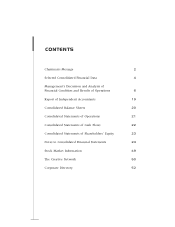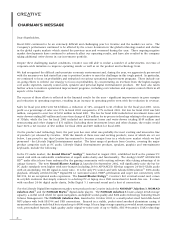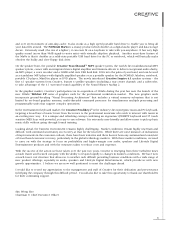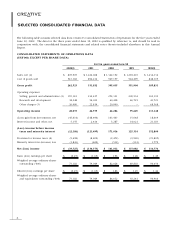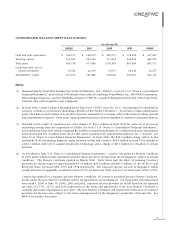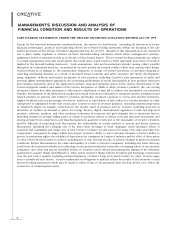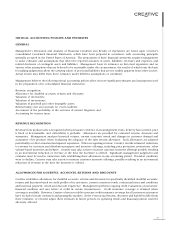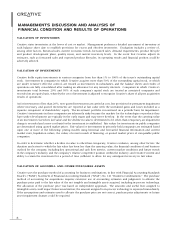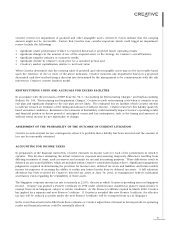Creative 2002 Annual Report Download - page 9
Download and view the complete annual report
Please find page 9 of the 2002 Creative annual report below. You can navigate through the pages in the report by either clicking on the pages listed below, or by using the keyword search tool below to find specific information within the annual report.
7
CRITICAL ACCOUNTING POLICIES AND ESTIMATES
GENERAL
Management’s Discussion and Analysis of Financial Condition and Results of Operations are based upon Creative’s
Consolidated Condensed Financial Statements, which have been prepared in accordance with accounting principles
generally accepted in the United States of America. The preparation of these financial statements requires management
to make estimates and assumptions that affect the reported amounts of assets, liabilities, revenues and expenses, and
related disclosure of contingent assets and liabilities. Management bases its estimates on historical experience and on
various other assumptions that are believed to be reasonable under the circumstances, the results of which form the basis
for making judgements about the carrying values of assets and liabilities that are not readily apparent from other sources.
Actual results may differ from these estimates under different assumptions or conditions.
Management believes the following critical accounting policies affect its more significant estimates and assumptions used
in the preparation of its consolidated financial statements:
Revenue recognition;
Allowances for doubtful accounts, returns and discounts;
Valuation of inventories;
Valuation of investments;
Valuation of goodwill and other intangible assets;
Restructuring costs and accruals for excess facilities;
Assessment of the probability of the outcome of current litigation; and
Accounting for income taxes.
REVENUE RECOGNITION
Revenue from product sales is recognised when persuasive evidence of an arrangement exists, delivery has occurred, price
is fixed or determinable, and collectibility is probable. Allowances are provided for estimated returns, discounts and
warranties. Management analyzes historical returns, current economic trends and changes in customer demand and
acceptance of its products when evaluating the adequacy of the sales returns allowance. Such allowances are adjusted
periodically to reflect actual and anticipated experience. When recognizing revenue, Creative records estimated reductions
to revenue for customer and distributor programs and incentive offerings, including price protection, promotions, other
volume-based incentives and rebates. Creative may take action to increase customer incentive offerings possibly resulting
in an incremental reduction of revenue at the time the incentive is offered. Significant management judgement and
estimates must be used in connection with establishing these allowances in any accounting period. If market conditions
were to decline, Creative may take action to increase customer incentive offerings, possibly resulting in an incremental
reduction of revenue at the time the incentive is offered.
ALLOWANCES FOR DOUBTFUL ACCOUNTS, RETURNS AND DISCOUNTS
Creative establishes allowances for doubtful accounts, returns and discounts for specifically identified doubtful accounts,
returns and discounts based on credit profiles of its customers, current economic trends, contractual terms and conditions
and historical payment, return and discount experience. Management performs ongoing credit evaluations of customers’
financial condition and uses letters of credit in certain circumstances. Credit insurance coverage is obtained when
coverage is available. However, Creative often is not able to procure credit insurance coverage for all customers as insurers
have excluded certain customers and geographic markets. In the event actual returns, discounts and bad debts differ from
these estimates, or Creative adjust these estimates in future periods, its operating results and financial position could be
adversely affected.



